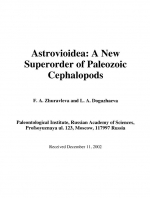Добрый день, Коллеги. Важное сообщение, просьба принять участие. Музей Ферсмана ищет помощь для реставрационных работ в помещении. Подробности по ссылке
Astrovioidea: a new superorder of paleozoic cephalopods
A new superorder of Paleozoic eclochochlian eephalopods, Aslrovioidea superordo nov., is designated. A distinctive feature of this superorder is that the soft eameral tissue enters the siphon cavity and secrets calcareous eameral deposits. This resulted in the destruction of the connecting rings that previously constituted, in conjunction with the septal necks, the compound wall of the siphon. In early (Ordovician) representatives of this superorder, the soft eameral tissue passed through the siphon to destroy, either partially or completely, the connecting rings and to progress occasionally along the internal surface of those rings that remained unde-stroyed as far as several chambers (the order Lituilida Starobogalov, 1983).
In later (Silurian and Devonian) astrovioids, the eameral tissue entered the siphon cavity through the septal foramen. The episcptal portion of the eameral tissue destroyed the connecting ring and mewed over the septal neck to the earlier chamber to be fused with the hyposeptal portion of the eameral tissue located in this chamber. Subsequently, it gradually secreted calcareous deposits thus squeezing the soft siphon in the septal neck. As eameral deposits accumulated, they filled the cavities of chambers and often came out from them to move toward the siphon and squeeze the soft siphon not only in the septal necks, but (in the absence of connecting rings) in the interspaces between them as well (the order Pallioceralida Marek, 1998). A detailed examination of thin and polished sections of newly found and some previously published Silurian and Devonian pallioceralids by an optical microscope and, what is more important, by a scanning electron microscope has shown that, in those parts of lhe phragmoconc within which eameral deposits reached into the siphon cavity, the connecting rings were completely destroyed, thus allowing direct connection between the soft eameral and soft siphonal tissues. In addition some new taxonomieally important details of lhe internal structure of shells have been revealed. Thus, it has been found that many laxa of this group of eephalopods formed in the siphon cavity a longitudinal layer of calcareous deposits that passed through all chambers over the epi-and hyposeptal deposits that filled the chambers. We propose the term melacameral deposits for these deposits. Furthermore, some pallioceralids contain calcareous deposits that in the absence of connecting rings were secreted by the siphon directly in the chamber cavity to meet the eameral deposits. These deposits will be referred to as ectosiphonal deposits. The microstructure of lhe eameral, melacameral, and eclosiphonal deposits have been examined with the aid of SEM.
These new data on the internal structure of pallioceralid shells and a detailed analysis of the literature that has been made in the light of these data allow the extension of the composition of this order and the development of a new classification. Thus, the order Pallioceralida now includes 5 families, 15 genera, and 32 species. The following new taxa have been separated: the families Flowerinidae, Oslreioceratidae, Astroviidac, and Plicalo-ceralidad the genera Astrovia (with the type species A. adorea sp. nov.), Ostreiocems (with the type species Sinoceras riphaeum Zhuravleva, 1978), and Syndikoceras (with the type species 5. arcticum sp. nov.); and the species Astrovia marhoumensis sp. nov., Syndikoceras mutveii sp. nov and Plicatoceras bublichenkoi sp. nov. At present pallioceralids are known from the Wenloek through the Eifelian of Europe, Asia, Africa, and North America.
The fact that in the order Lituilida eameral deposits penetrated into the siphon cavity and resulted in a destruction of connecting rings during the life of the organism was convincingly shown by Sweet (1958), Flower (1978), Dzik (1984), and other authors. The superorder Aslrovioidea existed from the Early Ordovician to approximately the Middle Devonian (Eifelian) and was virtually worldwide.




